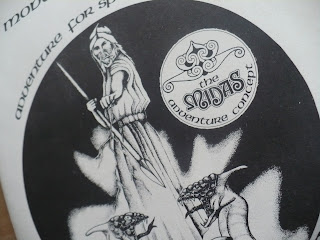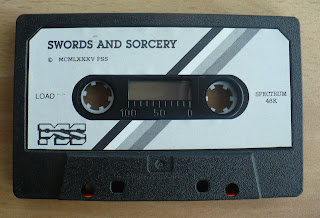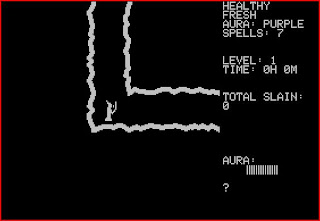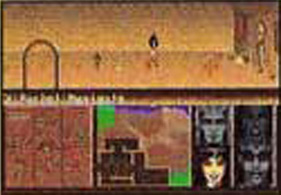 |
| Front Box |
 |
| Front Box, Bottom close up |
 |
| Front Box, Top close up |
 |
| Back Side |
 |
| Back Side, Close up |
 |
| Back Side, Top close up |
 |
| Spine |
 |
| Manual |
 |
| Cover Manual, Close up |
 |
| Back Manual, Close up |
 |
| Tape, Spectrum 48k version |
 |
| Sorcerer of Siva, desktop screenshot of a first gaming session |
 |
| Epyx Welcome Screen |
 |
| Main Screen |
 |
| Skill Level and Speed Factor menu |
 |
| And here you are into the Caves of Siva |
Energy & Fatigue
Casting spells, fighting, and running about in the mines naturally make you tired. While the computer keeps precise track of exactly how much physical energy you have from moment to moment, the display shows only five basic states of fatigue: FRESH, TIRING, TIRED, WEARY, or EXHAUSTED. The fresher you are, the faster you strengthen your magical aura (that is, the faster you recover the mental/mystical energy expended in casting spells). When you are EXHAUSTED, you cannot increase your aura rating, and you cannot perform physical activities such as moving or fighting.
You can recover from fatigue in either of two ways. The first is the simplest and slowest: just rest by typing 0 (zero)—that is, moving zero feet—or do something else requiring no energy (e.g., the S or E commands). Although the computer will make the appropriate adjustments each time you rest, you may have to do this several times before you notice a change in the printed display. (After all, you can't go from being EXHAUSTED to being FRESH simply by pausing for a few seconds of rest.)
You can regain physical energy much faster by using the energy spell (N), but this, of course, will drain you of some of the mental energy shown under AURA.Source: Sorcerer of Siva, Instructions Manual, p 17
 |
| Trapdoor and Wyrm |
 |
| Scoring Screen |
When you finish your game, you will be given a score that takes in many factors: the speed and skill level you selected, the treasures you accumulated, the state of your health and aura, and so on. Two considerations, however, are of overriding importance: Did you find your way out of the mine, or did you get killed? And did you slay the sorcerer?
Don't expect to get all the way through the mine on your first try, even if the skill level and speed factors are set to 1. As you gradually learn the secrets of the mine and its treasures, you can keep the game challenging by adjusting the skill level and speed factor appropriately. This will also increase your possible score, but you will find it more difficult to do as well with the added handicap. If you can triumph on Skill Level 8 and Speed Factor 10, you are a wizard.Source: Sorcerer of Siva, Instructions Manual, p 16
 |
| Main TRS 80 Cover, Source : Hardcore Gaming 101 |
Amulets, rings, necklaces, scepters, -oh, yes, and a pair of old boots - await you in the magical mines of Siva. Magic and riches abound. But wealth is not all you seek.The only entrance seals behind you as you enter the dark stillness of the mine. Armed with only a dagger and your magical abilities, you have but a few short hours to seek out the secret exit (hidden somewhere on the fifth level) before you are sealed in for all time. But beware the wandering soulless creatures that dwell in the more than 300 chambers of the magical mine, guarding every treasure and lurking beneath every trap door.A wizard you are, yes, who can hurl a fireball or lightning bolt to slay the blood-thirsty banshee; put an end to the deadly demon, or goad the goblin waiting to waylay you.Your spells can create openings in solid walls and sealed entrances, heal your wounds, restore your strength, or give you the gift of weightlessness which lets you move effortlessly from room to room. Your own bravery will decide how many spells you shall bring into the mines. But beware the evil Sorcerer, who is waiting to cast his favorite spell - forgetfulness - to deprive you of your most valuable magic.But all is not lost... You may regain a spell or two or, perhaps, if you can discover the wondrous touchstones no archaeologist has yet found - stones with powers to increase your magical abilities. Though, expect not that these, or others, always lie still, for the Sorcerer and his minions are afoot.Be warned, too, that not all treasures you might find are true. Mysterious items might drain your life's blood and leave you in blackness. Will a ring bring you only wealth? Can a pair of old boots do more than protect your soleful feet? In experience lies wisdom.Good luck! And happy mining...
The Mines of Siva consist of five floors or levels containing a total of more than three hundred chambers and passages. You begin each game on the bottommost floor (Level 1) and finally exit the mines, if you are lucky, from the top floor (Level 5). Each level except the top one has several stairways leading to the next higher level. You can go up a staircase simply by using the I (or A) command.
Once you have ascended the stairs, the computer will load in the new level automatically. (If you have a cassette version of the game, you should leave your recorder in PLAY mode for this purpose.) You cannot go back down stairs. However, you may be forced to start over from the first level—from below the first level, in fact. If you step on a trapdoor, it may open beneath your feet, prompting the computer to announce, TRAPDOOR!! You will then find yourself plunging through darkness into an uncharted area of the mines called the Underworld.
 |
| Apple II Screenshot, Source : Hardcore Gaming 101 |
Source: Sorcerer of Siva, Instructions Manual, p 22The SorcererYour nemesis in the Mines of Siva is the sorcerer. He will not attempt to kill you directly nor even inflict physical harm. Rather, from a safe and hidden vantage he directs his monstrous minions to come at you with fang and claw. Still worse, his personal attacks are directed at the very source and substance of your magic power. Each time he appears and casts a spell of forgetting, you lose your most powerful remaining spell!The only way to kill the sorcerer is with a well-aimed bolt of lightning. Unfortunately for you, the sorcerer (being more than a bit of a coward) will not dare confront you unless you are already battling for your life against one of the monsters of the mine! Then you must choose between defending your powers or your life! If you are unable to cast a bolt of lightning, you have no choice but to flee whenever the sorcerer appears.If you manage to slay the sorcerer, you will not only prevent any further loss of your magical abilities, but you will also, indirectly, eliminate those monstrous beings (such as an efreet, a djinn, or an elemental) that are summoned or created by the magic of the sorcerer.
 |
| Hellfire Warrior, Cover Manual, 1980 |
 |
| Fighting Fantasy Software Packs full page advertising, Sinclair User, January 1984, p.16 |
 |
| The Warlock of Firetop Mountain Software Pack, 1984 |
 |
| The Warlock of Firetop Mountain Software Contents, 1984 |
Stunning 3D Graphic Animation simulating video disk games.
A unique fully interactive adventure language using the latest ARTIFICIAL INTELLIGENCE techniques.
State of the art data compression techniques enabling enormous scenarious and vocabularies to be incorporated.
Real Time Interactive Conflict Sequences. Talk to your opponent, attack them, flee them and even confuse them.
Joystick capability for movement, combat and actions through unique menu feature. Keyboard operation for more complex interaction with the adventure when time permits.
Develop your own unique characters. For example - specialize in magic, swordplay etc.
Total expandability - your own characters can be transferred to future adventures and new opponents, scenarious and objects can be added to all the games. A series of expansion modules to increase indefinitely the playing life of each game written with MIDAS.Source: Swords and Sorcery Official Full page advertising.
 |
| Crash issue 10, page 73 |
 |
| Crash issue 26, page 77 |
 |
| Home Computing Weekly issue 81, page 21 |
 |
| Personal Computer Games issue 12, page 110 |
 |
| Popular Computing Weekly issue 85, page 5 (Only Spectrum version) |
 |
| Advert in a 1987 not confirmed Magazine showing the U.S. Gold/Adventure Soft (UK) release. |
 |
| White Wolf Magazine, May/June 1992 Advertisement |
Source: http://www.thekyngdoms.com/forums/viewtopic.php?t=37When we heard that TSR objected to the umbrella title, I immediately contacted NEC and JVC to determine if they would object to a name change to avoid a lawsuit one likely to have little merit, but costly. They agreed with my assessment and I changed the umbrella title to Dangerous Journeys.Despite that, TSR sued, attempting to get a temporary injunction preventing release and sale of the new game products. In this they failed.GDW and the rest involved in the project, the big companies plainly excluded, were sued for copyright infringement of the AD&D and D&D games. At this point the biggies dropped out of things, not wanting to become in the lawsuit. This was devastating to us, of course, because we were certain that if they joined us, TSR would have had no recourse but to drop the action, as the corporation was not financially able to fight against powerful corporations. The TSR complaint was patently ridiculous, of course, but to a court totally unfamiliar with RPGs, not worthy of dismissal before proceeding. Imagine someone not familiar with either chess or checkers. So the publisher of the checkers game goes to court claiming chess infringes on checkers. Your Honor, look at the similarities: the board is exactly the same, the game is played by two opponents, each side has pieces called men and there are kings in play. Moves alternate and are varied and, as in checkers, chess pieces can promote to be more powerful. To top that off there are captures, and one side eliminates the other to win! . That was the sort of thing we were facing.
+-+0002.jpg) |
| Dangerous Journeys Necropolis Module, Back Page AD, 1992 |
+-+0001.jpg) |
| Dangerous Journeys Necropolis Module, Back Page AD with the release date, 1992 |
Gary Gygax’s Dangerous Journeys™ Super CD Adventure Game
Coming soon for the new Turbo Duo is TurboGrafx Super CD version of Gary Gygax’s Dangerous Journeys™, a new Mulitgenre Roleplaying Game System, This product can be used on the new Turbo Duo platform or the TurboGrafx CD accessory system with system-upgrade card. Initial release of the Dangerous Journeys product is planned for April, 1993.
For more information contact 1-800-366-0136Dangerous Journeys is a trademark of Omega Helios Limited.TTI Turbo Technologies, Inc.
 |
| Turbo Play Magazine, Issue #02 September 1992, Preview Box at the Bottom of the page |
 |
| Turbo Play Magazine, Issue #04 Spring 1993, Top Left Screenshot and Description |
 |
| Dangerous Journeys Videogame Preview Screenshot, Turbo Play Magazine Issue #04 |
 |
| Dangerous Journeys Videogame Flyer, TTI, http://video-game-ephemera.com/014.htm |
Howdy!
No, the bogus lawsuit filed by T$R back in the 90s closed the door on the deal we had with Nintendo/JVC. After that I did a number of CRPG designs, two of which that were oprioned for development but never got into production for reasons not related to the game itself.
Anyway, the material I am speaking of was not one of the two game designs sold, but rather one that was a stand alone product. I never got it far enough along to do a formal proposal to any publisher. After the second CRPG (after the MYTHUS ONE) was accepted, word came on a Monday it was going forward into development, and on Wednesday we were told the company was sold and all projects were being canned, I decided I would return to paper games once again... Thus that design, along with some 20 or so others is lauguishing somewhere in this place, in disk limbo if you will.
Source: http://www.pcenginefx.com/forums/index.php?topic=3223.70;imodeFarewell to Dangerous Journeys CRPG so.